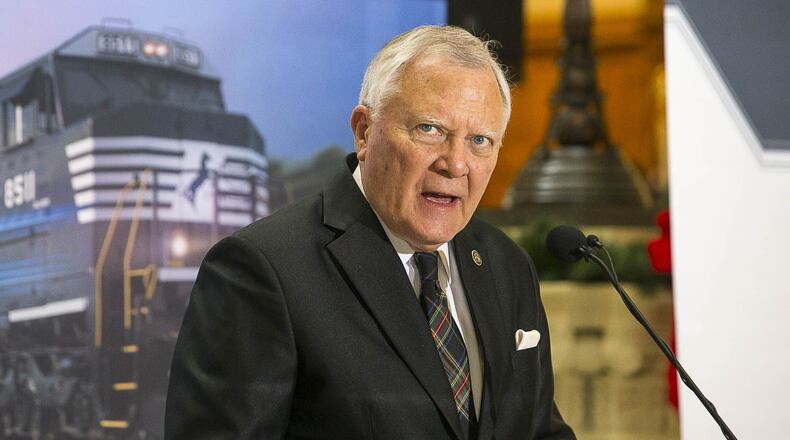Norfolk Southern made official Wednesday what was long expected — that the company’s headquarters is moving from Virginia to Atlanta.
The formal announcement that Georgia had coaxed the railroad giant out of Norfolk to a future glitzy office complex in Midtown is a swan song of sorts for Gov. Nathan Deal, who has made economic development one of the cornerstones of his two terms in office.
It also marks what will likely be the capstone in the political alliance forged between Deal and former Atlanta Mayor Kasim Reed, which continued unabated under Mayor Keisha Lance Bottoms.
VIDEO: More on Norfolk Southern
At the center of that pact between a Republican governor and Democratic mayors was an acknowledgement that jobs were political capital on both sides of the aisle. Critics, meanwhile, have said the alliance has given away too much in tax subsidies and other perks to wealthy corporations who don’t need them.
And it highlights a key question for the incoming administration of Gov.-elect Brian Kemp, who hailed Norfolk Southern’s decision to choose Georgia, about whether that alliance between the Gold Dome and Atlanta City Hall will endure.
On Wednesday, Deal and Bottoms were in the mood to celebrate Georgia’s newest Fortune 500 denizen. The project not only brings hundreds of new high-paying corporate jobs to Atlanta, but lays the tracks to start development of a $5 billion mixed-use project in downtown Atlanta’s Gulch.
“This is a great thing to end on, if in fact it is my last time to do so,” said Deal, whose finishes his second term in January.
“It really shows you want we can accomplish when we’re all working in the same direction,” Bottoms said.
Credit: Alyssa Pointer
Credit: Alyssa Pointer
Negotiations like the one for Norfolk Southern have become a hallmark of the state-city alliance, one that was forged by a governor who has a knack for leveraging relationships across party lines to hash out business deals, said Sandy Springs Mayor Rusty Paul.
“The state is changing rapidly, and Nathan has a better sense of that than just about anyone I know,” said Paul, a former Georgia GOP chairman. “He gets the undercurrents in the state and he knew he could take the political risks in forming coalitions that wouldn’t have been possible 20 years ago. And he made it work.”
The seamless state-city cooperation were a reason Jim Squires, the railroad giant’s chief executive, said the company chose to bring 850 new and relocated jobs to the city over the next several years to join some 2,000 existing employees in Midtown.
“Atlanta is the center of our network operations,” he said. “Over time Atlanta became the operations heartbeat of our company.”
The Gold Dome-City Hall alliance paved the way for Mercedes-Benz Stadium, NCR’s Midtown headquarters, the recruitment of Fortune 500 homebuilder PulteGroup from Michigan and even aided projects outside Atlanta’s city limits. Reed helped the region recruit Mercedes-Benz’s North American headquarters to Sandy Springs; kept Porsche’s North America headquarters here; and lobbied the Obama White House for funding to deepen the Savannah harbor.
Saving the Gulch project
Some economic development deals are more convoluted than others. Norfolk Southern set a new standard: It was arguably the most complex of the corporate relocations that Deal and the city of Atlanta landed during the governor’s two terms.
It started a few years ago when the city, state and developer CIM Group began discussing a plot of land owned by the railroad firm smack in the middle of the Gulch, the unsightly warren in the heart of downtown. CIM wanted the land for a $5 billion mini-city planned between the Five Points MARTA station and Mercedes-Benz Stadium.
Those talks soon morphed into a chance for Georgia to win the $575 million home office of one of the nation’s biggest railways. Norfolk Southern eventually agreed to move to a site in Midtown — but it needed to sell the Gulch land first.
It wasn’t easy. The land is one of the most challenging development sites in the state.
Developers envision glittering office towers, posh retail outlets and a dense cluster of residences there one day. But now it’s a 40-acre swath of dirt and sunken parking lots that’s crisscrossed by rail lines and sandwiched between the stadium and the Five Points MARTA station.
To create a street grid supporting at least a dozen blocks, CIM aims to build a $700 million platform to raise the development site 40 feet — high enough to weave into the surrounding streets while preserving space for trains to operate underneath.
Before CIM would buy Norfolk Southern’s land, the California-based developer wanted the city and state to forgo decades of future sales and property taxes to help fund the project and costly infrastructure. The public tab could reach nearly $2 billion.
Georgia lawmakers approved the state’s piece of those changes in 2017 with little debate. But winning the approval of city councilmembers took an all-out lobbying effort.
Opposition groups quickly sprang up, arguing that the deal amounts to a “welfare check” to a powerful developer. Community leaders and some councilmembers complained of a lack of transparency.
The debate over that incentive package dominated city politics for more than two months.
Diplomacy in flip-flops
To get the City Council’s sign off, Deal and Bottoms both ratcheted up the pressure.
In public, Deal took the rare move of wading into city politics. He urged council members to approve the Gulch project and turn the forlorn land into a “revenue producer rather than just a hole in the ground” — not least because the state owns a giant chunk of the sprawling property.
In private, his administration was forcefully advocating for the changes. His top aide, Chris Riley, met with city council members to detail the state’s investment in the project — and warn the Norfolk Southern headquarters hung in balance.
One Friday meeting was so hastily arranged that Riley showed up to City Hall after a workout in flip-flops and an Atlanta Hawks T-shirt to join the mayor to discuss the deal with three wavering council members.
In another rare move, the Deal administration dispatched Bert Brantley, a top state economic development official, to an hours-long listening session on the Gulch to answer any questions from residents and politicians about the deal’s impact.
After months of intense debate, the City Council narrowly agreed in November to support the potential 10-figure public financing package.
Soon after, Norfolk Southern sold its land to CIM, paving the way for Wednesday’s announcement.
The city, meanwhile, approved a nearly $24 million package of tax breaks for the railroad headquarters to be built by Atlanta-based Cousins Properties at West Peachtree Street and Ponce de Leon Avenue. State tax credits for newly created jobs and other perks could increase the value of the incentive package by millions more.
The Gulch development deal, however, isn’t quite finished, as legal challenges to bonds needed to start development are pending.
The council’s vote happened on the eve of a divisive gubernatorial election that Kemp later narrowly won in a runoff after openly warring with Bottoms on the campaign trail.
One of the first steps he took after setting his transition team: Walking the 300 steps to City Hall to defuse tensions with Bottoms.
She’s taken a similar outlook, saying the two can reach a “common denominator” on jobs, which is where she said his interests also lie.
“What I know is what’s good for the city is good for the state,” Bottoms said.
Why it matters
The Norfolk Southern relocation is Gov. Nathan Deal’s final major economic development achievement – and perhaps the most complex. It required a series of complicated land deals that involved downtown Atlanta’s Gulch, and a vigorous lobbying effort from the governor and Atlanta Mayor Keisha Lance Bottoms. The railroad giant will invest $575 million in a new Midtown headquarters that will bring 850 new jobs to Georgia.
Keep Reading
The Latest
Featured






